“We take care of the cow and the cow takes care of us,” says Marayal, a farmer in Thalavady, Tamil Nadu. Her two cows produce 6 to 10 litres of milk a day, which she sells for 30-40 cents per litre.
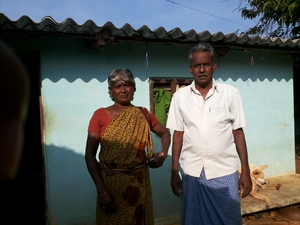
Seventy million rural households in India – well over half of the country's total rural families – keep dairy animals. Over half of the milk they produce, mainly buffalo milk, goes to feed people in the communities they live in, while a quarter of it is processed locally into yoghurts, ghee (clarified butter) and other dairy products.
India's dairy sector employs around 90 million people, of which 75 million are women. It is a significant source of income for small and marginal farmers, the landless poor and millions of rural families. And it is still India's biggest agricultural sector, contributing 22% of total agricultural GDP. The country is the world's largest milk producer, accounting for over 15% of the total global dairy output. Milk is an essential part of the Indians' diets. Almost all 108 million tonnes of dairy produced annually is consumed domestically.
Much is made of the significance of India's dairy cooperatives in the “white revolution” which saw a tripling of milk production between 1980 and 2006. But the real story lies with the people's milk sector, which still accounts for 85% of the national milk market. It was India's small-scale farmers and domestic markets who were the real basis for the massive expansion in the country's dairy production over those years, and, as a result, the benefits of this boom in production have been widely distributed.
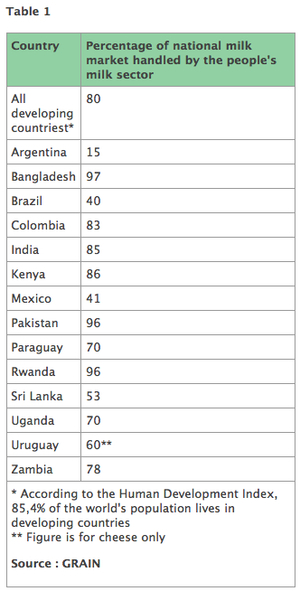
Corporate hands off the people's milk
But India's dairy sector has faced great challenges in recent years and the direction taken so far in negotiations over free trade agreements such as the India-EU FTA point to more difficulties ahead. With Western economies in crisis, India represents potentially rich pickings for powerful transnational corporations. The India-EU FTA essentially represents the demands of big corporations.
EUCOLAIT, the representative association of the European dairy trade and industry, is calling on EU negotiators to insist that the EU be given the same level of access to the Indian dairy market as India grants to other countries. In a December 2011 statement, EUCOLAIT highlighted India’s position as the world’s largest dairy consumer and said that India could become a consistent dairy importer. It says the EU should thus remain firm in negotiating an ambitious agreement delivering real market access for EU companies in the dairy sector.1
Against this, there is strong domestic support in India for the government to take adequate steps to protect the interests of the country's small dairy producers. On a parliamentary panel in April 2013, the members of parliament on the Committee of Agriculture stated that the interests of dairy producers in the country should be protected from monopolies and discriminatory and lopsided trade practices. There is also strong pressure from farmers’ movements to halt the India-EU FTA, which will create further liberalisation in the country and destroy India's agriculture sector, and the dairy sector in particular.
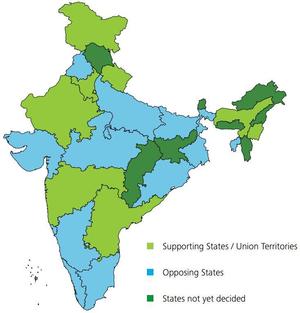
To get around the initial opposition to its foreign direct investment policies for retail, the Indian central government left the final decisions with the state governments. So far, of the country's 30 state governments, only 10 of them have stated they are fully in favour of the revised FDI policies, while seven states are opposed and the remaining ones have yet to take a position. The position of the state governments closely matches the strength of dairy co-operatives in the states. In some states, such as Karnataka, there is a high level of government involvement in the dairy co-operatives, which also provide an important source of government revenue.
The role of co-operatives in the Indian dairy sector
There are around 96,000 dairy co-operatives in India, ranging between the primary, district and state level. Karnataka is one of the states where the role of co-operatives has been crucial. The Karnataka Milk Federation (KMF) is the largest Cooperative Dairy Federation in South India, owned and managed by milk producers of Karnataka State. KMF has over 2.23 million milk producers in over 12,066 Dairy Cooperative Societies at village level, functioning under 13 District Cooperative Milk Unions in the state.
One of the district level co-operatives in Chamrajanagar receives 85,000 to 90,000 litres of milk a day from its 225 primary level co-operatives. The milk is collected twice a day from 60 bulk milk collection centres, on average one centre for every five villages, and then transported to the chilling centres in Chamrajanagar town. There are three giant chilling tanks in the district with a capacity of 30,000 litres each.
Farmers who sell the milk to the co-operatives receive payment of between 7 to 21 rupees per litre (11-34 cents), depending on the level of solid non fat (SNF) that is measured using lactometers available in each collection centre. The average level of SNF in milk that the co-operatives receive is 8.4%. The milk is then packed into 1 to 2.5 litre packages for sale, under the Nandini brand. The Karnataka Milk Federation sells the milk to consumers for 32 Rs per litre (50 cents).
Karnataka produces a total of five million litres of milk annually, easily exceeding the state's consumption of three million litres. The surplus is processed into powdered milk (skim milk powder and whole milk powder) by SKA Dairy Foods, a private company contracted by the government through a tender process. The co-operatives pay SKA 2.5 paese per kg of milk powder (100 paese = 1Rs). The cooperative in Chamrajanagar has huge storage with capacity of 85,000 kg of milk powder. As the selling price of milk powder is ten times the price of fresh milk, milk powder is an important product of the cooperative along with ghee. Part of the milk powder production is used by the Government of Karnataka for its school children food subsidies program, which provides skim milk powder for children in grades 1-6 and whole milk powder to class 7-10. The remaining surplus is then sold to other states like Tamil Nadu, and even to Delhi. It is a major source of income for the state.
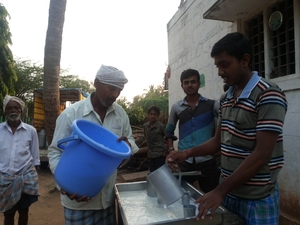
The Karnataka cooperative and others have huge capacity to collect milk directly from farmers and bring it to market. Mega dairy farms, in contrast, have little interest in doing this. Instead, many big dairy companies seek to import powdered milk from Europe or New Zealand to meet demand.
The cooperatives have also played a crucial role in resisting the India-EU FTA. Amul, a major dairy cooperative from the state of Gujarat, wrote letters to the Minister of Commerce expressing its strong opposition to granting any kind of advantage in terms of import duty on dairy products.
Make Way for Mega Dairy Farms
India's new FDI and trade policies not only open the country up to dairy imports, they also facilitate the takeover of local dairy production and processing. In 2011, the Carlyle Group, one of the largest private equity firms in the US, bought a 20% stake in Tirumala Milk Products, a private dairy company that handles 1.2 million litres of milk daily from its procurement and distribution network in Andhra Pradesh, Karnataka and Tamil Nadu. A year later, the French dairy giant Danone began negotiating the purchase of a controlling stake in Tirumala. That same year, Rabobank made an $18.5 million equity investment in Prabhat Dairy of Maharashtra through its India Agribusiness Fund. In August 2013, Rabobank invested another $12 million in Prabhat while the French development finance institution Proparco put in $9 million.
Part of this foreign investment in dairy production is driven by broader foreign investment in the food sector. As companies like McDonald's enter India, so do their main global suppliers. When McDonald's began opening restaurants in India in the late 1990s, its main dairy supplier, US-based Schreiber Foods, created a partnership with the wealthy Goenka family to establish a large dairy-processing company in Maharashtra, now called Schreiber-Dynamix.
The company set up contract farming and collection centres to collect milk from local farmers, but also began building up its own large-scale farm to supply its needs. In November 2010, the company inaugurated a "future ready" 6,000-cow dairy farm on 120 hectares in Pune District, with backing from the State Bank of India. Dynamix also supplies Danone, Nestlé, Yum! and Kentucky Fried Chicken. In February 2013, Nestlé made direct investment in a milk collection company linked to Schreiber-Dynamix by acquiring a 26% stake in Indocon Agro and Allied Activities Pvt Ltd, which is engaged in the milk collection business in western India.
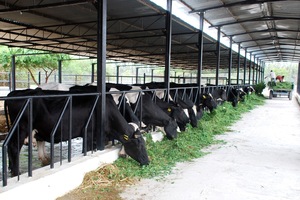
GDH also has plans for mega dairy farms in other locations. In a December 2010 presentation it described three farm projects that it was pursuing: the one in Nellore with IFFCO and Fonterra, a second for 3,500 cows in Bangalore with a "strategic local partner" with a target for operations starting in 2011, and a third for 3,500 cows with a local partner in North Coastal Andhra Pradesh, on the border with Orissa.
The multinational grain trading corporation Cargill also has plans to enter the Indian dairy sector. In 2010, Cargill announced that it would be investing in dairy farms in China and India through its hedge fund Black River Asset Management. Later in 2012, Black River's subsidiary, Cargill Ventures, made its first investment in the Indian dairy sector. It invested US$15 million (INR800m) in Dodla Dairy, also based in Andhra Pradesh, in Nellore. Dodla initially had investment from Indian private equity firm Ventureast.
Dairy and India's food sovereignty
“We don’t really intend to be dairy farmers, but it is part of our life,” Marayal says. For farmers like her, cows and buffaloes provide a steady and sustainable income.
The vibrant network of small producers and milk cooperatives that makes up most of India's dairy sector is a powerful model: one which is now threatened by free trade agreements and liberalised investment policies.
Opening up access to import heavily subsidised milk powder and other milk products from the European Union will allow processors and retailers to put downward pressure on local milk prices, forcing farmers to accept prices below the costs of production.
This is why India's farmers, cooperatives and trade unions have been at the forefront of protesting against the EU-India free trade agreement over the past year. They understand that high tariffs are a necessity. Far from leading to higher prices for consumers, such tariffs will protect against dumping and prevent big processors from substituting cheap, processed dairy – or even non-dairy – products for real milk.
Investors and big dairy corporations are working hard to hijack dairy markets in India and across the South. In addition to its interests in India, Cargill is investing hundreds of millions in mega dairy farms in China. Fonterra is also expanding aggressively in China and Brazil. If they succeed, it would spell economic and social disaster for millions of people.
But experiences elsewhere show that people's milk can successfully resist the powerful forces lined up against it. In Colombia, small producers, vendors and consumers formed an alliance that forced the government to recognise people's milk – leche popular – as legal and essential. This success was built on three key arguments. First, that people's milk presently meets the bulk of dairy needs and Big Dairy cannot replace it. Second, that millions of people's livelihoods depend on small dairy production; here too, Big Dairy offers no alternative. And finally, that the system of people's milk provides safe, fresh, nutritious milk at affordable prices to millions of households.
This is the system that needs to be defended as a cornerstone of food sovereignty in India, Colombia and elsewhere. Milk must remain in the hands of the people.
GRAIN acknowledges the support and collaboration of the South Indian Coordination Committee of Farmers' Movements and Kannaiyan Subramaniam on this publication.
Natural milk production: the people’s concern, not big business
by Linus Jayatilake, National Movement of Sri Lankan Dairy Farmers
People's participation in Sri Lankan milk production is still around 53%. If the Government of Sri Lanka is consistent with its policy of National Milk Production, they should end the importation of powdered milk. Immediate steps have to be adopted to concentrate on local production of fresh milk mainly for children and the sick. Even rationing of milk is advisable till we reach a glut of production.
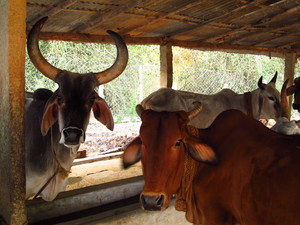
A Sri Lankan Bos indicus cow can give at least five bottles of milk (1 bottle = 750 ml) or more per day. This animal can thrive on various grasses and herbs. No concentrate feed is necessary at all. Therefore, it is a low cost production of milk full of cream and proteins. Buffalo populations of both the local and Indian breeds should be developed. The Sri Lankan Bos indicus breed should be utilised mainly for Integrated Agriculture and for ploughing and rural transport. Cow dung and cow urine are the most essential food for the soil - and the soil biota. The Indian farmers call it a Jeewa Amurthaya – the source of wealth – and the power of a Nation will depend on its healthy soil, its healthy plants and healthy living beings.
People's Milk is an engine of Poverty Alleviation and Health. It provides livelihoods and safe, affordable, nutritious foods. The revenues earned are distributed evenly and consistently throughout the sector. Everyone wins with people's milk, except for big business. And this is why there is such pressure to destroy it. What does Big Dairy have to offer? Instead of fresh, high-quality milk produced and supplied in the most sustainable ways, we are offered powdered and processed milk produced on highly polluting mega farms and sold in all kinds of packaging - at double the cost!
Going further
Nestlé becomes latest foreign corporation building mega dairy farms in China
Can India turn the tide on the supermarket tsunami?
Punjab Lok Sujag, The political economy of milk in Punjab: A people’s perspective, August 2003 (PDF)